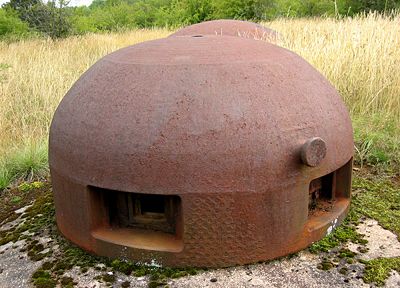
GFM cloche
Encyclopedia

Maginot Line
The Maginot Line , named after the French Minister of War André Maginot, was a line of concrete fortifications, tank obstacles, artillery casemates, machine gun posts, and other defences, which France constructed along its borders with Germany and Italy, in light of its experience in World War I,...
. A cloche (bell) was a fixed and non-retractable firing position made of a thick iron casting which shielded its occupant. By comparison, turrets could be rotated and sometimes lowered so that only the top shell was exposed.
GFM is an acronym for Guetteur et Fusil-Mitrailleur, (lookout and rifle-machine-gunner), which describes its purpose as a lookout and firing position for light weapons. Most of the bunkers or blocks in a Maginot Line ouvrage were fitted with several fixed armoured cupolas or cloches. The cupolas were designed to allow the soldiers to perform reconnaissance or repel an attack with an absolute maximum of cover
Cover (military)
In military combat, the concept of cover refers to anything which is capable of physically protecting an individual from enemy fire. This differentiates it from the similar concept of concealment, in that an object or area of concealment only affords the benefit of stealth, not actual protection...
, from inside the bunker. The armament of each cloche varied significantly, but were typically equipped with some combination of:
- Light machine gunMachine gunA machine gun is a fully automatic mounted or portable firearm, usually designed to fire rounds in quick succession from an ammunition belt or large-capacity magazine, typically at a rate of several hundred rounds per minute....
s or automatic rifleAutomatic rifleAutomatic rifle is a term generally used to describe a semi-automatic rifle chambered for a rifle cartridge, capable of delivering both semi- and full automatic fire...
s - Vision blocks
- Mounted binoculars
- A periscope (located on the top of the bell)
- A 50 mm. mortar
Description
The cloche consisted of two sections of cast iron: a lining or base that sat over a corresponding circular shaft in the concrete combat block, and the cloche itself, for the 1929 model 2.7 metres (8.9 ft) tall and 1.6 metres (5.2 ft) in outside diameter, projecting about 0.52 metres (1.7 ft) above a concrete apron. The apron sloped away from the cloche for drainage and to allow a depressed field of fire. The interior contained a platform arranged so that one occupant could fire from one of several openings in the 20 centimetres (7.9 in) thick bell. Firing openings were rectangular, and were fitted with a variety of shutters or firing ports, typically stepped to deflect shots away from the opening. A hose could be attached to the weapon to remove gun fumes. Ear-like lifting points projected to each side of the exposed portion of the cloche.Variants
There were two principal types of GFM cloche, each with a set of subtypes. The 1929 Type A cloche was the initial model, with a short variant, a longer version, a wider version, and a model that could accommodate two soldiers. The 1934 Type B cloche was larger in diameter, with thicker armor. The gun ports were redesigned to fire through a ball fitting that was more resistant to opposing fire. Some Type A cloches were fitted with the new ports.Periscope
All GFM cloches possessed a shuttered fitting at the top of the bell through which a periscopePeriscope
A periscope is an instrument for observation from a concealed position. In its simplest form it consists of a tube with mirrors at each end set parallel to each other at a 45-degree angle....
could be raised.
See also
- VDP clocheVDP clocheThe VDP cloche was an element of the Maginot Line fortifications. A cloche was a fixed and non-retractable firing position made of a thick iron casting which shielded its occupant. By comparison, turrets could be rotated and sometimes lowered so that only the top shell was exposed. VDP cloches...
, observation cloche - JM clocheJM clocheThe JM cloche is an element of the Maginot Line. It is a non-retractable non-rotating cupola of steel alloy like GFM cloches, but are armed with twin heavy machine guns, as opposed to the lighter automatic rifles associated with the GFM. There are 179 JM cloches on the Maginot Line.JM is an acronym...
, heavy twin machine gun cloche - LG clocheLG clocheThe LG cloche was a defensive element common to many Maginot Line ouvrages. The fixed cupola was deeply embedded into the concrete on top of a combat block, with only the top surface visible. The opening permitted the ejection of grenades from the interior of the cloche, providing a means of...
, grenade launcher cloche

